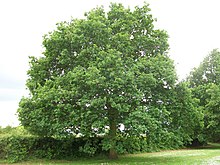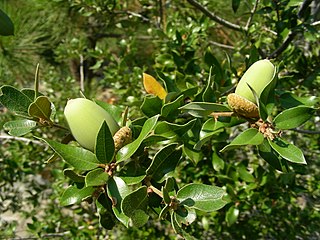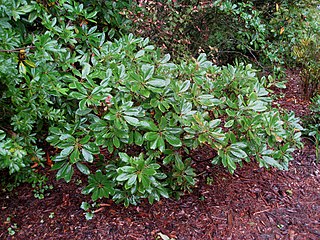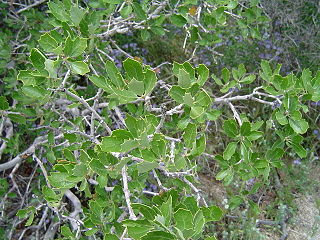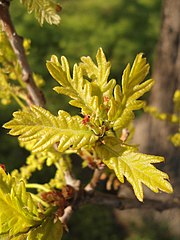
An oak is a hardwood tree or shrub in the genus Quercus of the beech family. They have spirally arranged leaves, often with lobed edges, and a nut called an acorn, borne within a cup. The genus is widely distributed in the Northern Hemisphere; it includes some 500 species, both deciduous and evergreen. Fossil oaks date back to the Middle Eocene. Molecular phylogeny shows that the genus is divided into Old World and New World clades, but many oak species hybridise freely, making the genus's history difficult to resolve.
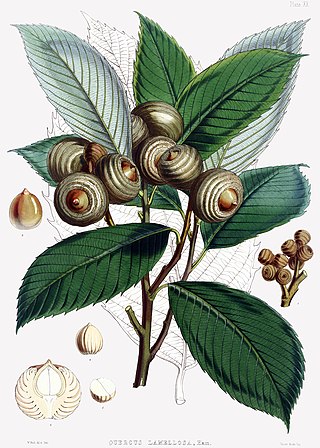
Quercus lamellosa is a species of oak (Quercus) native to the Himalaya and adjoining mountains from Tibet and Nepal east as far as Guangxi and northern Thailand, growing at altitudes of 1300–2500 m. The Lepcha of Sikkim call it book koong. It is placed in subgenus Cerris, section Cyclobalanopsis.

Quercus myrsinifolia is an Asian species of tree in the beech family Fagaceae. It has several common names, including bamboo-leaf oak, Chinese evergreen oak, and Chinese ring-cupped oak. Its Chinese name is 小叶青冈; pinyin: xiǎo yè qīng gāng, which means little leaf ring-cupped oak, in Japan it is called white oak and in Korea it is known as gasinamu (가시나무). It is native to east central and southeast China, Japan, Korea, Laos, northern Thailand, and Vietnam. It is placed in subgenus Cerris, section Cyclobalanopsis.
Quercus asymmetrica is an oak tree species in the beech family Fagaceae. It is found in China and northern Vietnam. It is placed in subgenus Cerris, section Cyclobalanopsis.
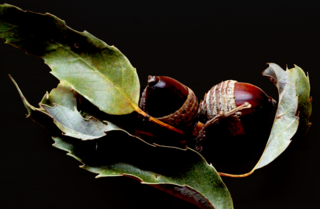
Quercus stenophylloides, also called Arisan oak, is a species of evergreen, broad-leaf tree endemic to Taiwan. It is placed in Quercus subgenus Cerris, section Cyclobalanopsis.

Quercus baloot, the holm oak or holly oak is a rare species of oak that was described by Griffith in 1848. It is classified in subgenus Cerris and section Ilex. It is native to the Himalayas from 1,000–3,000 metres (3,300–9,800 ft).
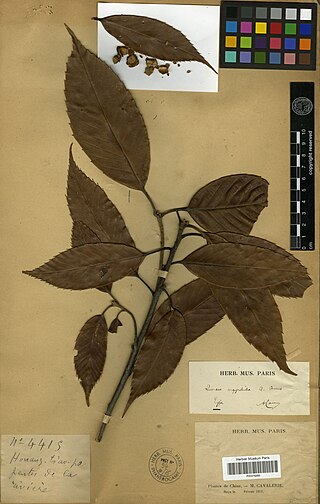
Quercus argyrotricha is a rare Chinese species of trees in the beech family. It has been found only in Guizhou Province in southern China. The common name is Chinese for this species is gui zhou qing gang.
Quercus austrocochinchinensis is an uncommon species of tree in the beech family Fagaceae. It has been found in Vietnam and Thailand as well as Yunnan Province in southern China. It is placed in subgenus Cerris, section Cyclobalanopsis.
Quercus blakei is an uncommon species of tree in the beech family Fagaceae. It has been found in Indochina and southern China. It is placed in subgenus Cerris, section Cyclobalanopsis.
Quercus chevalieri is an uncommon species of tree in the beech family Fagaceae. It has been found in Vietnam and also in southern China, in the Provinces of Guangdong, Guangxi, and Yunnan. It is placed in subgenus Cerris, section Cyclobalanopsis.
Quercus poilanei is an Asian species of tree in the family Fagaceae. It has been found in northern Indochina and also in the Province of Guangxi in southern China. It is placed in subgenus Cerris, section Cyclobalanopsis.
Quercus saravanensis is an Asian species of tree in the beech family Fagaceae. It has been found in northern Indochina, and also in the Province of Yunnan in southwestern China. It is placed in subgenus Cerris, section Cyclobalanopsis.
Quercus thorelii is an Asian species of tree in the beech family Fagaceae. The species is named after the French botanist Clovis Thorel. It has been found in Indochina and in southern China. It is placed in subgenus Cerris, section Cyclobalanopsis, the ring-cupped oaks.
Quercus langbianensis is an uncommon oak tree species in the family Fagaceae. It is placed in subgenus Cerris, section Cyclobalanopsis, the ring-cupped oaks. These differ from other Quercus groups in that they have acorns with distinctive cups: usually with substantial rings, made-up of scales that have grown together. This species can be found in sub-tropical and tropical seasonal forests of Vietnam.
Quercus petelotii is the accepted name of an endemic oak tree species in the beech family Fagaceae; there are no known sub-species. It is placed in subgenus Cerris, section Cyclobalanopsis.
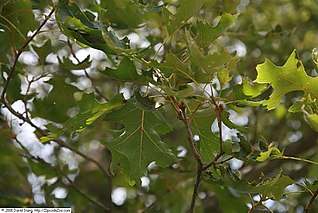
Quercus gomeziana is a tree species in the beech family Fagaceae. There are no known subspecies. It is placed in subgenus Cerris, section Cyclobalanopsis.
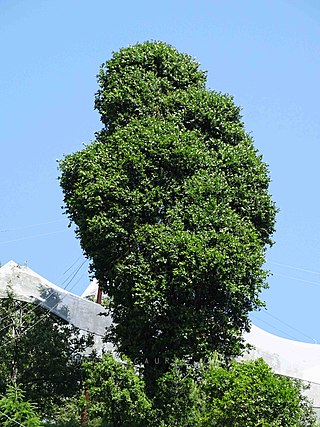
Quercus floribunda, called the Moru oak or Mohru oak, Tilonj oak and green oak, is a species of oak native to Afghanistan, Pakistan, India's western Himalaya, and Nepal, typically found from 2,000 to 3,000 metres above sea level. It is in the subgenus Cerris, section Ilex. An evergreen tree with a dense crown reaching 30 m (98 ft), it is an important fuelwood and fodder species.
Quercus look, the look oak or Mount Hermon oak, is a species of oak in subgenus Cerris, section Cerris, native to the Levant region of Western Asia, including northern Israel, Lebanon, and Syria. Of the local oak species, it prefers to grow at the highest altitudes, for instance at c. 1800 m on Mount Hermon.

Quercus subgenus Cerris is one of the two subgenera into which the genus Quercus was divided in a 2017 classification. It contains about 140 species divided among three sections. It may be called the Old World clade or the mid-latitude clade; all species are native to Eurasia and North Africa.
